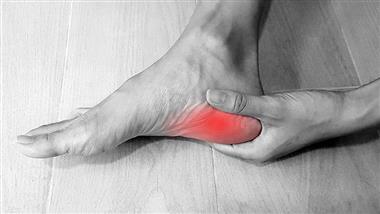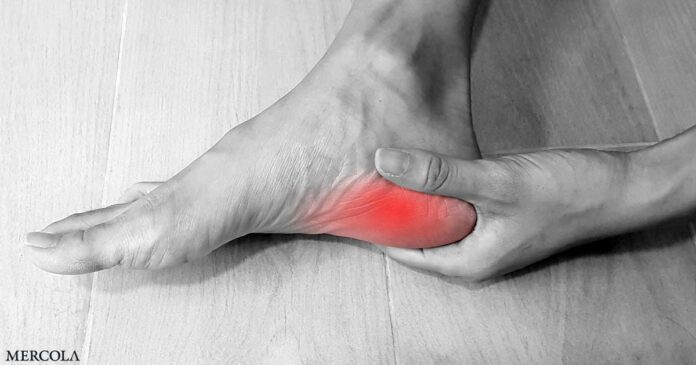
Story at-a-glance
- Plantar fasciitis (heel pain) is a common occurrence, especially among runners. While the pain is typically believed to be caused by inflammation in the ligament that runs along the sole of your foot, some research suggests other issues are at play
- Possible underlying causes and/or contributing factors include inflammation or microscopic tears in the plantar fascia, stress fractures, enlargement of the plantar fascia, tight Achilles tendon and loss of arch support if you have flat feet
- Anything that places stress on the plantar fascia is a risk factor for plantar fasciitis, including both intrinsic and extrinsic factors
- The pain of plantar fasciitis is typically gradual in onset, and most noticeable when you’re taking your first steps after getting out of bed in the morning or after prolonged sitting
- Treatment recommendations include rest, plantar fascia stretches, ice massage, dorsiflexion splint, platelet-rich plasma injections, soundwave therapy, laser therapy and possibly acupuncture
Editor’s Note: This article is a reprint. It was originally published December 28, 2018.
Plantar fasciitis (heel pain) is a common occurrence, especially among runners. Unfortunately, the exact underlying cause is still being debated. While the pain is typically believed to be caused by inflammation in the ligament that runs along the sole of your foot, connecting your heel bone to your toes, some research has shown plantar fascia pain can occur even in the absence of inflammation. According to one such study:1
“Findings include myxoid degeneration with fragmentation and degeneration of the plantar fascia and bone marrow vascular ectasia. Histologic findings are presented to support the thesis that ‘plantar fasciitis’ is a degenerative fasciosis without inflammation, not a fasciitis.
These findings suggest that treatment regimens such as serial corticosteroid injections into the plantar fascia should be reevaluated in the absence of inflammation and in light of their potential to induce plantar fascial rupture.”
Possible Causes of Plantar Fasciitis
It appears plantar fasciitis can be triggered in a number of different ways, some involving inflammation and others not. Possible underlying causes and/or contributing factors include:2
|
Inflammation of the plantar fascia due to excessive stress placed on the heel bone and soft tissues. The ligament attachment is located at the bottom of your heel bone, which is why the pain is felt in your heel. Improper footwear is typically part of the problem, and research3 by Michael Warburton, a physical therapist in Australia, found that running barefoot decreases the likelihood of plantar fasciitis |
|
Microscopic tears in the plantar fascia |
|
Stress fractures to the bones of your heel |
|
Myxoid degeneration (this is when the connective tissue is replaced by a gelatinous substance) |
|
Collagen necrosis (a form of cell injury that results in the premature death of the cells, in this case collagen, a crucial component of connective tissue) |
|
Hyperplasia of the plantar aponeurosis (enlargement of the plantar fascia) |
|
Overly tight Achilles tendon |
|
Loss of arch support (if you’re flat-footed) |
Risk Factors
As noted the 2016 paper, “Management of Plantar Fasciitis in the Outpatient Setting,”4 anything that places stress on the plantar fascia is a risk factor for plantar fasciitis, and these risk factors can be divided into intrinsic and extrinsic factors. Additional factors are also mentioned in a systematic review5 of diagnostic and treatment strategies for athletes.
- Intrinsic factors include obesity, flat footedness (pes planus), excessively high arches (pes cavus), reduced range of ankle dorsiflexion, tight calf muscles, overpronation, leg-length discrepancy, excessive lateral tibial torsion and/or femoral anteversion, tight Achilles tendon, weakness in the foot muscles, heel fat pad atrophy or aging, and plantar fascia stiffness
- Extrinsic factors include overuse, running on hard surfaces, walking barefoot, a sudden increase in running intensity and/or volume, prolonged walking or standing and inadequate footwear
Diagnostic Elements
The pain of plantar fasciitis is typically gradual in onset, and most noticeable when you’re taking your first steps after getting out of bed in the morning or after prolonged sitting. Aside from the presentation of pain in your heel, other diagnostic elements include:6
• Evaluation of intrinsic and extrinsic risks
• Blood testing, checking for inflammation markers
• Ultrasonography imaging of your plantar fascia. According to the outpatient treatment guidelines, this “is a very useful and reliable tool in diagnosing plantar fasciitis.” That said, imaging is typically unnecessary unless the problem is resistant to treatment, or to rule out other heel pathology.7
The plantar fascia thickness in asymptomatic healthy adults ranges from 3.3 millimeter (plus or minus 0.3 mm) to 3.9 mm (plus or minus 0.5 mm). A thickness greater than 4.0 mm is considered abnormal
Treatment Recommendations
Treatment recommendations for plantar fasciitis — some of which I will describe further in sections below — include:8,9,10
|
Rest and activity modification — If you’re a runner and you feel mild pain in your heel, know that this is a warning sign and if you keep running, it’s only going to get worse as the plantar fascia gets increasingly irritated.11 Orthopedic experts will often recommend avoiding running for four to six weeks, and doing nonweight-bearing exercises such as cycling, swimming or rowing instead. Once you’re asymptomatic (no longer in pain), you can gradually return to load-bearing activities |
|
Plantar fascia stretch — As described in “Management of Plantar Fasciitis in the Outpatient Setting:”12
|
|
Using a dorsiflexion splint at night — Many patients notice improvement after four weeks of use and resolution of symptoms within 12 weeks |
|
Platelet-rich plasma injections |
|
Extracorporeal shockwave therapy (ESWT) — Recommended for chronic cases (pain lasting six months or longer) |
|
Photobiomodulation therapy — Near infrared light can be a very powerful healing therapy by facilitating the development of structured water in your tissue that promotes healing and decreases inflammation. This can be administered by digital LEDs or analog heat lamp bulbs. In my experience the heat lamp bulbs are far superior |
|
Acupuncture — In one small trial,13 patients who received five acupuncture treatments per week for two weeks reported improvement in plantar fasciitis pain |
While cortisone and anti-inflammatory drugs are also typically prescribed, I would suggest exercises and other nondrug alternatives first, which is the focus of this article. Aside from offering only temporary relief, side effects of corticosteroid injections include fat pad atrophy and plantar fascia rupture.14
Exercises for Plantar Fasciitis
Aside from the plantar fascia stretch described above, other exercises that target your foot, calf and Achilles tendon are recommended. The featured video demonstrates a program consisting of five exercises that target plantar fascia pain:
- Wall stretch, to stretch and elongate your calf muscles
- Tennis ball massage, to stretch your plantar fascia
- Pick up a sock or towel with your toes, to tone your plantar fascia
- Seated calf stretch
- Belt stretch
Shockwave Therapy — ‘Closest Thing to Miracle Cure’ for Plantar Fasciitis
While surgery is sometimes recommended for stubborn cases that are resistant to treatment, ESWT (extracorporeal shock wave therapy)15 may be a far preferable alternative, and may eliminate the need for surgery altogether. As previously noted by podiatrist Dr. John E. Mancuso:16
“Our team of specialists at Manhattan Podiatry Associates, PC, in Midtown and Downtown Manhattan, are no strangers to plantar fasciitis. In addition to providing lifestyle modifications that alleviate heel pain, we also offer radial extracorporeal shock wave therapy …
Shock wave therapy can be a first line defense for plantar fasciitis, especially if you’ve tried other options such as orthotics, stretching, exercise modifications, physical therapy, or night splints without improvement. Shock wave therapy isn’t right for pregnant women, people with clotting disorders, or anyone with an open wound on their foot.”
ESWT does have some caveats; for example, you should not undergo ESWT if you are pregnant, have bone cancer, are taking anticoagulants or have had a steroid injection within the past 12 weeks. You also may experience some pain or discomfort, which is usually manageable, although some doctors may administer a local anesthetic to help make you comfortable.17,18
According to Dr. Amol Saxena, a podiatrist specializing in sports medicine at the Palo Alto Medical Foundation and sports medicine editor of the International Advances in Foot and Ankle Surgery journal, ESWT “is the closest thing we have to a miracle cure” for plantar fasciitis.19
Another Surgical Alternative — Ultrasound Therapy
Another alternative is ultrasound-assisted treatment of the damaged tissue with a hollow needle. Sedation isn’t necessary with this procedure since it takes only about a minute and a half to do. In one study, patients with chronic fasciitis reported a 90% improvement or more after two weeks. As reported by Medicinenet.com:20
“During the ultrasound therapy, doctors guided a hollow needle tip into an area of ‘problem’ tissue by means of ultrasound guidance. Once in position, the tip targeted a combination of high frequency/low amplitude sound to the damaged foot region. That broke up the pain-generating tissue, which was then extracted out of the foot.
In total, average treatment time was about a minute and a half, and sedation was not used. According to the study, by two weeks after treatment, patients showed more than a 90 percent improvement (on average) in their foot disability assessments, compared with their pre-treatment status.”
Eat an Anti-Inflammatory Diet
Specific herbs and individual foods are also known for their anti-inflammatory contributions. These include but are not limited to:
- Herbs and spices such as garlic, cloves, ginger, rosemary and turmeric
- Berries such as blueberries, strawberries and cherries
- Animal-based omega-3 fats found in sardines, anchovies, mackerel, wild-caught salmon, fish roe and krill oil
- Shiitake mushrooms
- Fermented vegetables and traditionally cultured foods (which quell inflammation by reseeding your gut with beneficial bacteria that help optimize your immune function)
Foods to avoid, as they increase the inflammatory response in your body, include:
- All forms of sugar (glucose, fructose, high fructose corn syrup, sucrose) and artificial sweeteners
- Refined carbohydrates
- Excessive alcohol (as it too turns into sugar)
- Artificial trans fats and processed vegetable and seed oils, such as corn oil and canola oil
- Processed meats
Collagen for Soft Tissue Injury and Repair
As mentioned earlier, collagen necrosis is one possible cause of plantar fasciitis, but even if it isn’t, taking extra collagen is probably going to be a good idea if you have plantar fasciitis. I interviewed Mark Sisson about the importance of collagen for soft tissue injury and repair, and you can find more information in that article.
In short, tendons, ligaments, cartilage and fascia — basically connective tissue — are all collagen-based tissue that tend to get weaker and less elastic with age. These connective tissues require very specific raw materials, namely animal-based collagen such as gelatin and bone broth (sourced from organic grass fed animals), in order to heal.
This collagen material is amino acids that get incorporated into your body to become this matrix of connective tissue. There are no hard and fast rules on dosage though. When treating his Achilles tendinosis, Sisson opted for a larger-than-normal dose and took 20 grams of collagen twice a day to start. After a few months, he cut down to a maintenance dose of 20 grams a day. Within four months, his Achilles’ were much improved.
- 1J Am Podiatr Med Assoc. 2003 May-Jun;93(3):234-7
- 2,4,8,11,12,14Singapore Med J. 2016 Apr; 57(4): 168–171
- 3Sport Science 2001: 5(3)
- 5,6,10Muscles Ligaments Tendons J. 2017 Jan-Mar; 7(1): 107–118
- 7Am Fam Physician. 2011 Sep 15;84(6):676-82
- 9British Journal of General Practice 2012 Aug; 62(601): 443–444
- 13Evid Based Complement Alternat Med. 2011; 2011: 154108
- 15,17ESWT for Plantar Fasciitis (PDF)
- 16Manhattan Podiatry. How Shock Therapy Works for Your Plantar’s Fasciitis
- 18ESWT USA 2018
- 19Time June 27, 2018
- 20Medicinenet.com March 1, 2015
Source: Original Article
Publish Date: 2024-01-18 12:28:46

